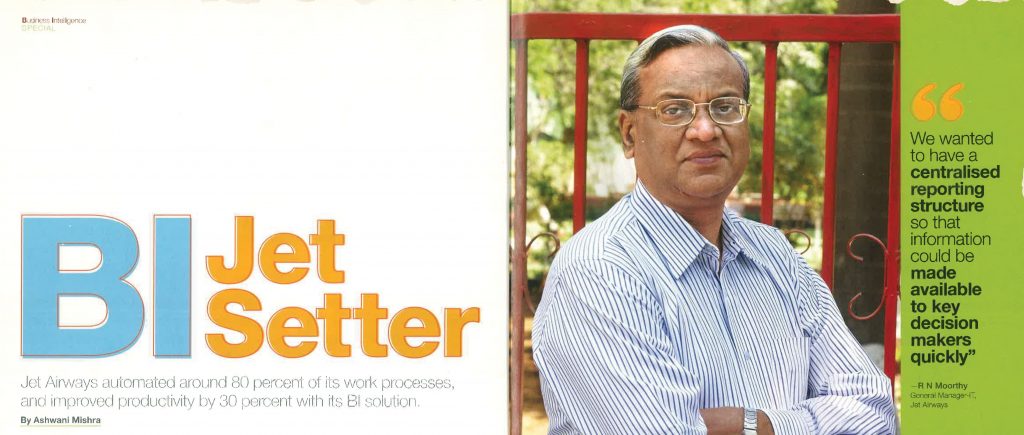Jet Airways automated around 80 percent of its work processes, and improved productivity by 30 percent with its BI solution. By Ashwani Mishra

For let Airways getting one version of the truth across all business functions was a hurdle that the company wanted to overcome effectively. Information dissemination within the organization was not standardised there was dependency on excel sheets for conducting data analysis, and reconciling numbers periodically posted a big challenge.
The company was operating on disparate systems and the data from all these systems was not in sync with the ground reality.
For example, if the company wanted to look at the financial data for a month in a particular year, it had to wait till the end of the next month to get the required data. So there was a month’s lag in getting the required information.
“We wanted to have a centralized reporting structure so that information could be made available to key decision makers quickly”. Says R N Moorthy, General Manager-IT, Jet Airways.
To address these concerns, the company embarked on a BI roadmap way back in 2006. When it decided to implement the SAP Data Warehouse to generate its MIS out of the existing SAP ERP system.
The system was implemented with the help of partners, who helped in the initial design along with the in-house IT team, Later the company only consulted its technology partners while the development and implementation was done by the internal team.
Towards the end of last year the company implemented the SAP Business Objects (BO) analytical tool on top of its ERP and Dara Warehouse to further increase its decision-making capabilities.
“The key reason for the implementation was the growth in business and used for quicker data analysis, says Moorthy.
GETTING DATA RIGHT
The number of aircrafts had gone up from 25 to 212 (Jet Airways and JetLite combined) that compelled the company to deploy an intelligent data reporting system. Before deploying this solution, the airline used to have reports but they were on a transaction based system (where the data was fed) and getting the data out from the central data warehouse for analytics and reporting was quite a cumbersome task.
With the BO tool in place, the airlines now is able to generate reports on time and has improved the decision making process Jet Airways officials says that the BO tool has helped in making almost 80 percent of company’s work automated. The tool helps analyse the data at finer granularity and is available to employees across the organisation based on their roles. Currently more than 150 business users within Het are using the system around the globe.
The Business Objects tool has also helped the company carry out route profitability and cost allocation at the most granular level.
“We can now find out a flight’s most profitable route, landing navigation rate, oil consumption and so on. With the weight of the aircraft, the oil and landing navigation, the cost goes up, Hence it’s important to look at the Profit and Loss (P&L), of every aircraft. All this information is now available in real time, ”Says Moorthy.
The company now carries out the P&L on flights every week and depending on the future booking loads they can, for instance, decide to combine two flights instead of flying two separate aircraft.
The financial data is now available within a week and personal productivity has increased by 30 percent. The company now has the capability to create dashboards for the management.
“We intend to take BI to the next level by using it for predictive analysis, and enabling on-demand BI in the next couple of years, ‘says Moorthy.
Important for readers: The interview was originally appeared in October 2010 in CIO&Leader (formerly known as CTOForum), featured as a segment of the Business Intelligence Special Issue titled “BRAIN OF THE MATTER.” In celebration of CIO&Leader’s 25th Anniversary milestone, this insightful piece has been revisited and republished as part of the nostalgic “From The Archive” series.